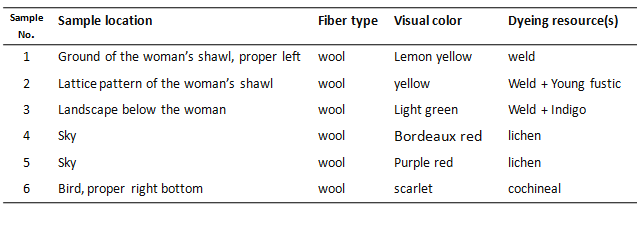Difference between revisions of "MFA 59.22, Embroidered picture by Ann Peartree, America (1739)"
(Created page with "== Artifact Information == Museum of Fine Arts, Boston 59.22. 27.7 x 23 cm. Linen plain weave embroidered with wool and silk. This is a pictorial embroidery of seated pip...") |
|||
| (4 intermediate revisions by the same user not shown) | |||
| Line 3: | Line 3: | ||
Museum of Fine Arts, Boston 59.22. 27.7 x 23 cm. | Museum of Fine Arts, Boston 59.22. 27.7 x 23 cm. | ||
| − | Linen plain weave embroidered with wool and silk | + | Linen plain weave, embroidered with wool and silk, (brown, blue and white silk in tent stitch). |
| − | |||
| − | |||
| + | Grassy, hilly landscape with seated figure of a woman holding a bouquet of flowers in left hand and a sickle in her right, possibly Summer; oak trees left and right. In foreground, Cupid, dogs, lamb, bird and flowers. Narrow strip of finer linen sewn across bottom,embroidered with blue silk in cross stitch "Ann Peartree 1739". Faded, true colors on back, some crewels gone in small areas [1]. | ||
| − | [[File:MFA | + | |
| + | [[File:MFA 59.22 small.PNG|center|frame|MFA 59.22 Embroidered picture. © Museum of Fine Arts, Boston. ]] | ||
== Summary of results == | == Summary of results == | ||
| Line 14: | Line 14: | ||
The samples were taken from the objects for dye analysis on 2/24/2011 by textile conservator Masumi Kataoka. All of the samples were taken from the reverse side of the textiles, which were considered to have been little exposed to light. The brightness of the original colors was still seen there. Samples were sent to Prof. Richard Laursen for analysis at Boston University. | The samples were taken from the objects for dye analysis on 2/24/2011 by textile conservator Masumi Kataoka. All of the samples were taken from the reverse side of the textiles, which were considered to have been little exposed to light. The brightness of the original colors was still seen there. Samples were sent to Prof. Richard Laursen for analysis at Boston University. | ||
| − | It was found that weld was used for yellow, cochineal for | + | It was found that weld and weld with young fustic was used for yellow, cochineal for scarlet red and lichen for a bordeaux red. |
| − | [[File: | + | [[File:MFA 59.22 result.PNG|center|frame|Dyes Analysis of MFA 59.22, by Prof. Richard Laursen, Boston University ]] |
== References == | == References == | ||
Revision as of 12:06, 21 August 2017
Artifact Information
Museum of Fine Arts, Boston 59.22. 27.7 x 23 cm.
Linen plain weave, embroidered with wool and silk, (brown, blue and white silk in tent stitch).
Grassy, hilly landscape with seated figure of a woman holding a bouquet of flowers in left hand and a sickle in her right, possibly Summer; oak trees left and right. In foreground, Cupid, dogs, lamb, bird and flowers. Narrow strip of finer linen sewn across bottom,embroidered with blue silk in cross stitch "Ann Peartree 1739". Faded, true colors on back, some crewels gone in small areas [1].
Summary of results
The samples were taken from the objects for dye analysis on 2/24/2011 by textile conservator Masumi Kataoka. All of the samples were taken from the reverse side of the textiles, which were considered to have been little exposed to light. The brightness of the original colors was still seen there. Samples were sent to Prof. Richard Laursen for analysis at Boston University.
It was found that weld and weld with young fustic was used for yellow, cochineal for scarlet red and lichen for a bordeaux red.
References
[1] http://https://www.mfa.org/collections/object/fragment-with-wrestling-lions-and-harpies-66254

